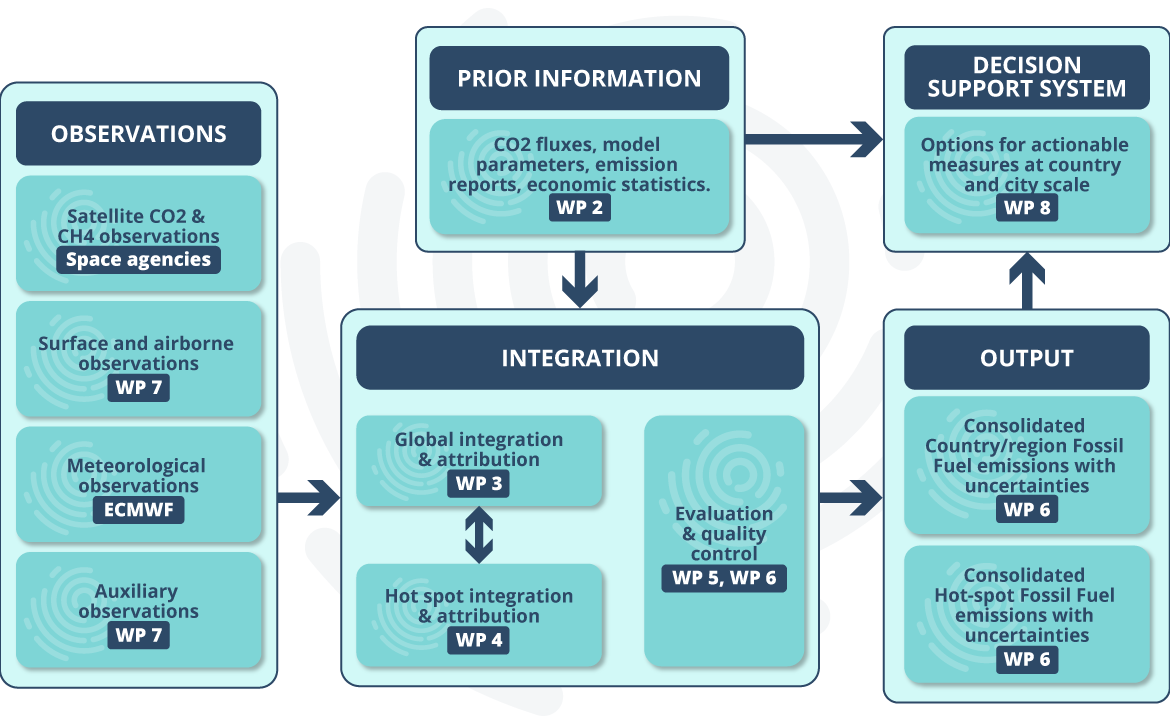CoCO2 will use a multitude of existing tools and data sets using the heritage of the CO2 Human Emissions (CHE) and VERIFY (Observation-based system for monitoring and verification of greenhouse gases) projects. While these tools and data sets form the basis for the work in CoCO2, they will be further developed as part of the overall methodology to meet the specified requirements for the overall Copernicus CO2MVS capacity.

In WP2 Prior and ancillary information state-of-the-art emission and emission uncertainty data will be generated as input for the modelling and data assimilation activities in WP3 (globally) and WP4 (locally). New methodologies will be developed to improve the emission and emission uncertainty data, with a special focus on making better use of timely activity data and energy statistics. In addition, spatially explicit uncertainty information will support the design of an observational network in WP5 connecting scales and uncertainties.
WP3 Global Modelling and data assimilation will deliver a system that can provide information of CO2 emissions and other surface exchange in near-real time, as well as in a longer-term re-processing mode to provide the most accurate annual estimates as possible and to evaluate trends in support of the Global Stocktake (GST) process. The core of this system is the Integrated Forecasting System (IFS) at ECMWF. Using the IFS for the global Earth system maximises the exploitation of synergies with existing Copernicus services and their development (CAMS and C3S) as well as with Numerical Weather Prediction (NWP) services and development. The work will focus on further developing the data assimilation capacity, disentangling anthropogenic emissions from natural carbon exchange, and the use of multi-species constraints for improved attribution of CO2 signals to individual processes (e.g., land-use change) or sectors (e.g., shipping or power plants).
WP4 Local and regional modelling and data assimilation involves the development and application of high-resolution atmospheric transport and inversion systems covering limited geographical areas and addressing scales from mesoscale weather phenomena to individual plumes as they are resolved by CO2M. The analysis and developments in this WP will rely on state-of-the-art transport models and inversion approaches applying improvements in their efficiency and robustness to ensure that they can be applied operationally.
WP5 Connecting scales and uncertainties will develop methods and mechanisms to transfer information among and between the different spatial scales and to ensure consistency between these scales. Within the CO2MVS, emission estimates will be generated by inversion systems operating at different scales, from global to regional to local. The regional limited-area models require boundary conditions, which are provided by the global model system, including the transfer of uncertainties. Reciprocally, the global system can benefit from the regional models running at higher spatial resolution and exploiting plume-resolving observations. In addition, this work package will investigate ways to evaluate posterior estimates and their uncertainties by means of model inter-comparisons as well as through the development of dedicated bench-marking metrics.
WP6 Integration, testing, application and initial validation of prototype systems will bring together the activities from work packages 2 to 5. In the short term, it will provide appropriate CO2 anthropogenic emission products for the 1st Global Stocktake (GST), at a spatial scale consistent with GST requirements. In the long term, it will build a comprehensive multi-scale prototype that will serve as the basis for the pre-operational Copernicus CO2MVS capacity. This prototype shall fully exploit current and future observations from the Sentinel missions to deliver CO2 emission estimates on time for the second GST with the best possible accuracy. WP6 will also support the design and implementation of an Evaluation and Quality Control (EQC) tool for the CO2MVS, building on existing approaches in the CAMS and C3S operational services and on the experience acquired for the 1st GST with real data. This EQC framework will address the service components at all scales.
WP7 Observations will support the activities in other work packages and further elaborate on the content of the Green Report from the European Commission’s CO2 Monitoring Task Force to provide more detailed information on the in-situ requirements of the CO2MVS versus current capabilities. CoCO2 will collect and document the in situ observation and ancillary data requirements of the CO2MVS, identify and contact providers of the required data streams and identify the gaps in the currently available in situ observations and ancillary data. Collaboration with stakeholders related to in situ observations, such as ICOS, TCCON, WMO and the European Commission is essential.
WP8 User engagement will engage with the various user communities to co-design a fit-for- purpose CO2MVS service portfolio and develop mechanisms and tools to provide diverse, but targeted information to these user communities. This will be achieved by several user consultation meetings and workshops, but also by using existing international communication and planning mechanisms. Special focus will be on a continued discussion framework between national reporting agencies and the CoCO2 scientific partners, as was established in the VERIFY project, with the aim to align the development of the CO2MVS capacity with the diverse requirements from these national reporting agencies. Ultimately, the Copernicus CO2MVS capacity should be embedded in the national processes providing information that is currently missing or difficult to generate at national scale.
WP9 Coordination, Dissemination, Exploitation and International Liaison will ensure the CoCO2 project is coordinated and project-managed in a timely and effective manner. It covers the administrative and financial support and will apply established quality management methods. WP9 will also maintain the liaison with the European Commission, ESA, the CO2 Task Force, ESA's CO2M Mission Advisory Group, EUMETSAT and other stakeholders, such as the Copernicus services, Global Climate Observing System (GCOS), Global Atmospheric Watch (GAW), IG3IS, CEOS/CGMS, GEO, WIGOS, and UNFCCC.